The Forgotten Villages of Ukraine’s ‘Zero Line’
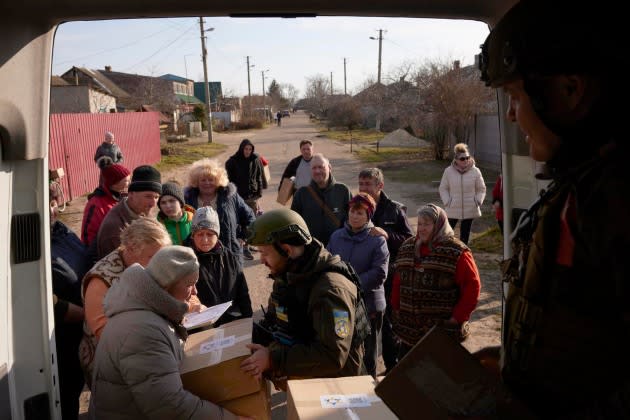
BILOZERKA COMMUNITY, UKRAINE – The van bursts out of a treeline and there is black smoke in the distance. I see it from the right side window as we turn east down a dirt road. “Where’s that coming from?” I ask the aid workers in the front seat. “I think where we’re going,” says the team lead, a slim woman named Julia. Where we’re going is a group of rural villages collectively known as Bilozerka, scattered over a few square miles of riverbank that’s right on the “zero line,” the direct border between Ukrainian land and Russian-held territory. Julia and her team are from a Ukrainian NGO called New Dawn, which specializes in operations like this: driving aid to the most vulnerable communities in the hardest to reach places, no matter what it takes to get there.
Everyone looks at their phones. Shelling in Bilozerka, one intelligence map tells me, but it can’t pinpoint the spot. The little icon of a bomb is right on the village we’re headed to. The smoke is a thick column that rises straight up and then hooks to the west, dissipating into a dirty black smear on the horizon. The van gets quiet. Someone remarks that the smoke must have been something big — a cruise missile or a bomb, not artillery, but everyone is just guessing. On the zero line it could be anything.
More from Rolling Stone
Iranian Weapons Are Now Being Used on Both Sides of the Ukraine War
Putin Continues to Terrorize This Ukraine City, Long After His Troops Left
Matt Gaetz Called Out for Citing Chinese Propaganda in Hearing
“When we stop, stay close to the van, OK?” Julia tells my photographer and me. “And keep your helmet on.”
By now, Ukraine’s major cities — Kyiv, Kharkiv, Mariupol, Kherson — are household names. Other smaller cities or suburbs, like Bakhmut or Bucha, break into the news by virtue of events too horrible to ignore. But there is another Ukraine, the invisible lives of thousands spread all along the war’s current 700-mile front. Outside of the cities, rural Ukrainians live in tiny villages largely forgotten by the media, the aid apparatus, and even the armies who ravage them. Life here is tenuous: Death lurks down side streets and in half-plowed fields sown with mines and shells. It visits in the night with no warning, dropping from the sky.
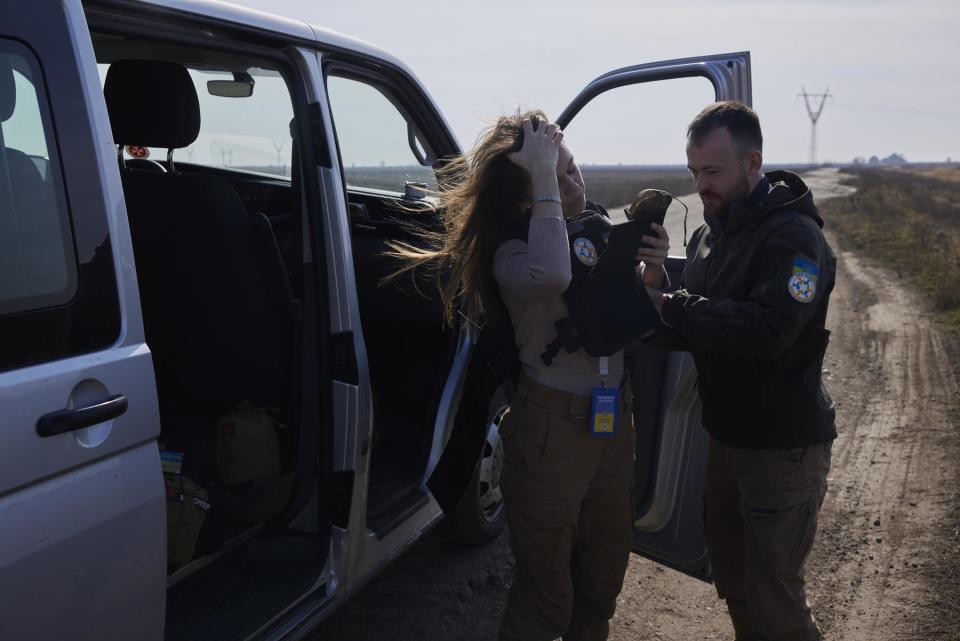
In early March, I visited half a dozen of these tiny front line towns in the Kherson region, many nestled right on the banks of the Dniper river, where the Russian military lobs shells and rockets from the opposite bank. Many — most — of the people in them have left. But some remain, clinging to their lives in homes roofed with blue tarps, their doors tied shut after soldiers have smashed out the locks. Their lifeline is a scattered network of aid workers for local and international NGOs, who have assumed the responsibility for distributing a hodgepodge of humanitarian aid to parts of the country that otherwise might simply fade away. The resilience of Ukraine’s cities is, by now, well publicized, as their citizens have defiantly reasserted normalcy wherever possible. But many rural villages are surviving through a combination of stubbornness and communal grace, underserved by both their own government and the international community, as a war with no clear resolution still threatens to sweep them away.
“Life has returned to the cities, which makes it feel like the war there is over,” Julia says. Her NGO is based out of Odessa, two hours or more from the front lines. “But you drive 250 kilometers and you see thousands of people living in the same conditions we experienced just a few months ago.”
In the Kherson region, aid has flowed into major cities. Mykolaiv, where the New Dawn team picks up my photographer Alex and I, was shelled by Russian troops for most of the duration of 2022. Now, it’s flourishing again, thanks to the Ukrainian counteroffensive last fall: bustling streets, new restaurants, fully stocked stores. Kherson, which Rolling Stone visited in early March, is still under constant bombardment, but its clear supply lines keep its remaining residents from suffering shortages of food or medical supplies. The region’s villages, however, are scattered along a patchwork warren of cratered dirt and barely-paved back roads (the quickest way to one, for example, is by taking a military pontoon ferry underneath the remnants of a destroyed bridge). Getting in and out isn’t easy — and though they’re now in liberated territory, most are still within range of the Russian guns.
The violence in these towns can be both logical and completely bewildering. Some ravaged towns have clear strategic import — the ones unlucky enough to be close to major highways or transit corridors. Others appear to have been decimated at random, just a few kilometers away from other villages that are largely untouched. Shelling comes and goes. It’s almost guaranteed in the towns closest to the zero line. It’s less common, but an errant rocket or missile can touch down almost anywhere within 30 kilometers of the Russian positions.
That 30 kilometer range — or thereabouts — is an invisible demarcation that every experienced fixer, aid worker, and soldier keeps in their head at all times. New Dawn left Mykolaiv in a six vehicle convoy, four vans and two large semi trucks, all loaded down with aid. As we lurched off of the main road, Oleg, the driver of the lead van, abruptly pulled off on a straight stretch in the middle of an open field: We’d come far enough that it was time for everyone to gear up. The convoy halted, and everyone got out and pulled on body armor. It was a gorgeous day – in the high 50s, clear with bright sun. But close to the zero line, even good weather feels like a risk: Clear skies make for easy flying for Russian planes and drones.
But for the next few hours, at least, the risks were still low. After 20 minutes of bumping along past scattered farms (and at least one camouflaged missile battery), the convoy rolled into the village of Pravdyne, a smallish hamlet that had been rocked by fighting and occupied by Russian troops. The trucks spent more than an hour offloading huge packages of food, pallets of water, and bundles of blankets and duvets to a crowd of villagers – many of whom drove or biked in from surrounding settlements. The recipients were mostly retirees, but a small gaggle of children came as well, running up to hug Julia. She ducked back into the van and emerged with a stack of glossy coloring books. She seemed so familiar with the kids that I asked how many times she’d done this run, expecting a figure in double digits. She said this was the second time she’d ever been there.
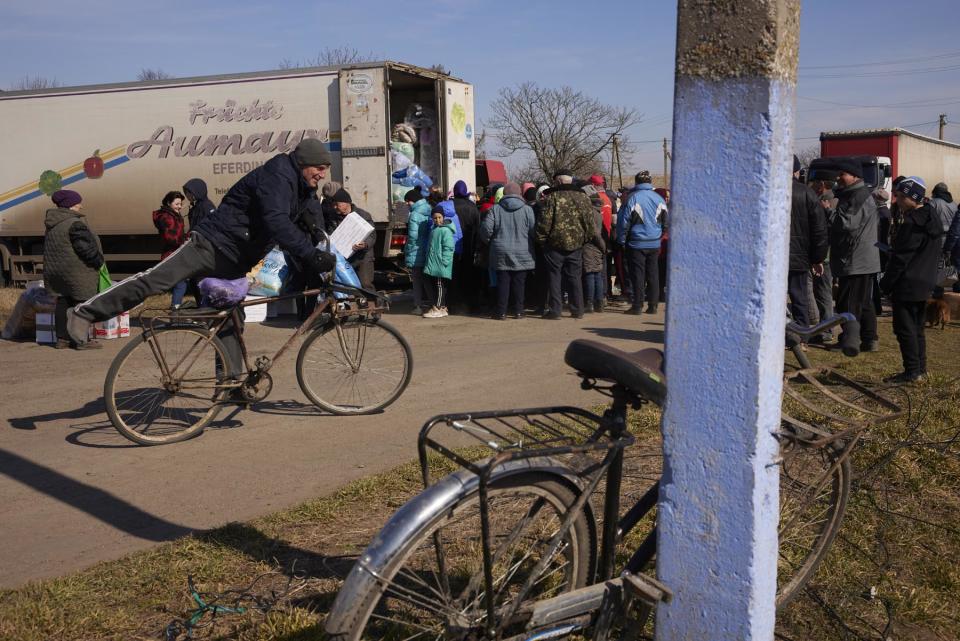
“This is the most under-covered region in Ukraine,” Julia says. “In the winter, just coming here and looking them in the eyes, saying ‘I remember you, there are people around the world who are thinking of you’ – it’s important. It lifts their spirits. It’s more important even than the food and water [we bring].”
There’s one resident she knows well, though: 70-year old Alya Ivanova, who rolls up on an ancient soviet bicycle to snag a box of food and some blankets. Alya is the town nurse, in charge of a half-destroyed medical clinic run by a donated generator and in sore need of supplies. A year ago, she said, her son died, at the age of 40. Like many parents who outlive their children, she said she spent time wondering why she wasn’t taken instead. But she imagined what he would say: “It’s because people need you.”
“I wanted to live, and help more and more people,” Alya says. She took that resolution seriously: during the war’s early days and the occupation, when the town was heavily shelled, she waved a white scrap of cloth above her head as she biked through the town on her rounds, insisting to the Russian soldiers that she be allowed to see every patient. She has worked in the village for 50 years.
We chatted for a bit, until Alya excused herself to go check on something else. She returned 10 minutes later with a banana, still slightly green at the top and clearly fresh out of an aid package. She insisted I take it; declining was not an option. Anyone willing to bike through a firefight is not someone you argue with.
We left Pravdyne in a much smaller column. Oleg and Slava, the lorry driver, slapped hands. Half the team loaded up into the trucks and other vans. Oleg’s van – with Julia, Alex, and I – would lead one other vehicle on the rest of the trip, closer to the zero line, to places it’s better to travel light.
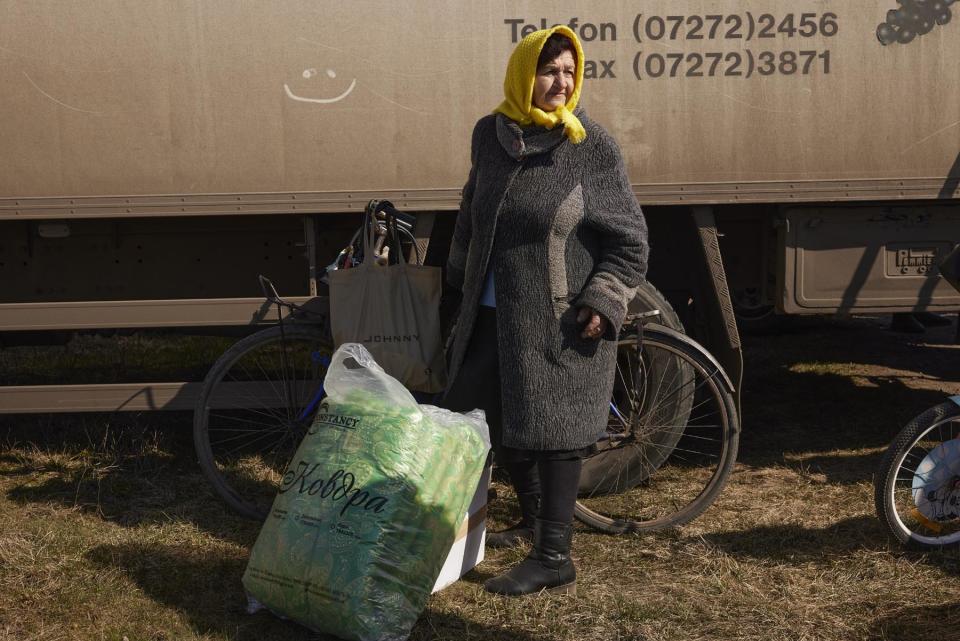
At the checkpoint outside of Bilozerka, the military tells us that journalists aren’t allowed closer to the zero line. The guards are friendly, but the smoke on the horizon makes it pretty clear why they’re hesitant. But the value of what New Dawn is bringing in apparently outweighs the risk of two journalists tagging along, and we’re eventually waved through. The van bumps down potholed and cratered roads toward Bilozerka proper, which is the largest of a sprawling community of villages that have been hollowed out by fighting along the river. As we approach, we realize the column of smoke is coming from somewhere out in the wide river delta between the Ukrainian and Russian sides, or perhaps the other bank. The delta itself is no-man’s-land — the site of fierce small arms fighting over control of marshy islands in between, battles that often play out in darkness, their only evidence the rattles and bangs overheard by civilians on the banks.
But these battles can spill over at any time. When we arrive in Bilozerka, Marina, the deputy mayor of the greater Bilozerka community, says that the village was shelled around 7:30 that morning. Shortly before we arrived, it was buzzed by two jet fighters – probably Ukrainian, but the villagers have no way to tell. Marina says that there are only 42 households left in Bilozerka itself, and a few dozen more in the surrounding villages. Oleg and the other boys unload half a van’s worth of food packages in a hurry, as Marina keeps tally of recipients on a clipboard. Julia, meanwhile, takes videos for New Dawn’s donors, showing them the direct impact of their aid. The stop takes a little more than five minutes, but we’re soon moving again, as Marina and the mayor pile into a car to lead us to the other settlements.
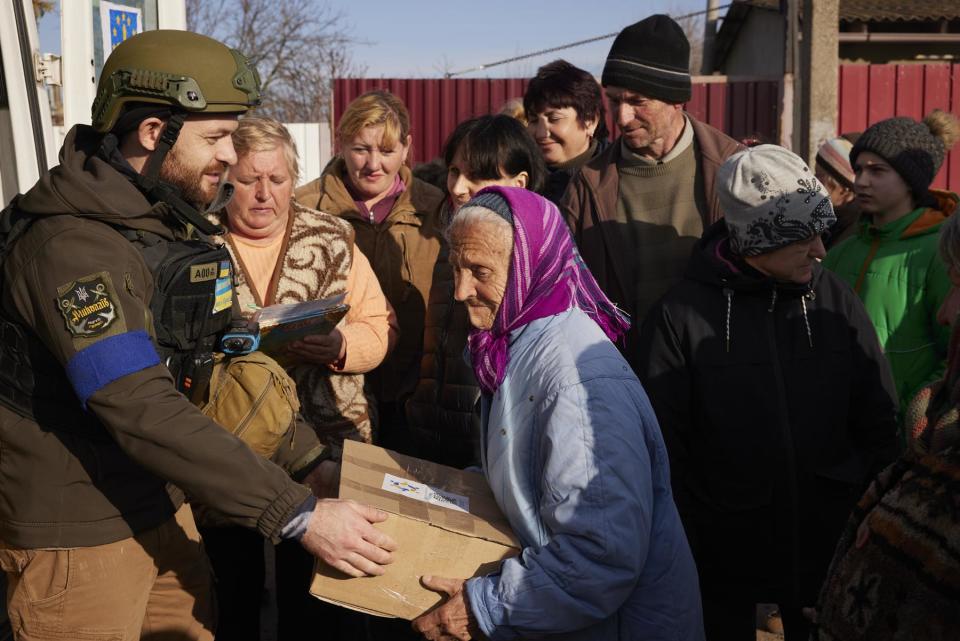
The next village, Dniprovske, is so close to the banks of the Dniper we have keep the vans in the town’s center, a couple roads back from the river. I’m curious, in a small village like this, how much access to that water means, so I ask Marina whether or not the villagers can still get down to the banks and fish. She immediately shakes her head no.
“If you go to the beach you can see the orcs running around,” Marina says. She means the Russians – visible to the naked eye sometimes on the islands and opposite bank. There’s no fishing anymore; the military has closed down the road closest to the river. “That’s the zero line,” Marina says, adding that the military tells them to stay off those streets for fear of snipers. She doesn’t look concerned, but the aid workers and I can’t help glancing at the sky. The clear skies are perfect weather for drones. The feeling of exposure is intense – Ukrainian artillery is busy in the surrounding area, sending sporadic booms through the village that no one but me seems to flinch at.
Still, it’s clear that New Dawn’s team is paying attention. At the next stop, we round a corner and Marina motions for us to pull up in front of a building that turns out to be the village’s winery. Oleg isn’t pleased – the spot has a direct line of sight to the river, and the vans are a perfect target. We compromise by shifting 50 meters or so down the road, where some pockmarked buildings offer some concealment. This town has only eight households left, Marina explains, living in the village’s seven remaining houses. Before the war it had hundreds. The winery used to ship its product to France and mainland Europe. The day before we arrived the Russians hit it with a rocket. The acres of vines behind it are stripped bare. “The orcs got free grapes all summer,” Julia mutters as we pass.
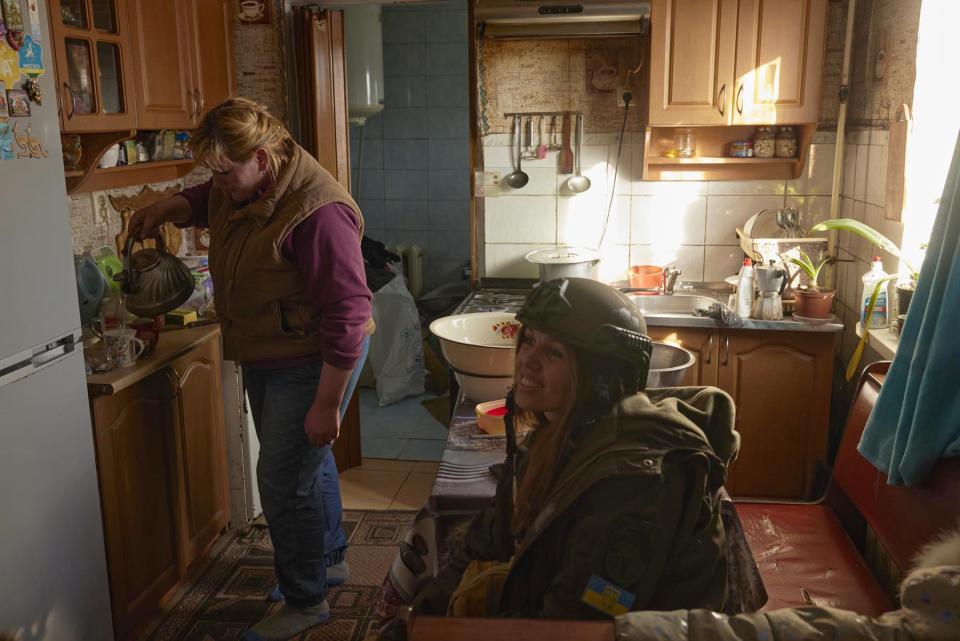
The next stop is much calmer. The village in this area, strangely, is almost untouched. There are a smattering of children here, waiting with their parents by a playground ringed with car tires painted bright colors. The vans start to empty out, packages of food going out in an orderly fashion. At the last village we visit, the vans pull into a narrow street sheltered on both sides. We’re further back from the river, but still well within range. As the last aid packages go out, one of the women invites us into her house for coffee. New Dawn is still trying to stick to their five minutes, but again – these offers you just don’t turn down.
As the rest of the team sips their cups, Julia and I chat with Lubov Stepanova, who bustles up to the van smiling to take her package of food. She is 69 years old and has a big grin filled almost completely with gold teeth. Lubov and Julia are laughing and joking; Julia is relaying my small talk and pleasantries to her. In every place we have been there is a palpable sense of joy at seeing new faces – Alex and I end up in several photos with tiny grandmothers half our height. It feels perverse, in some way, to keep asking these people about the war, asking them to relive the worst times of their life and remind them of the danger they still face. But often I don’t have to ask. Those memories are always there. In the middle of small talk, Lubov just starts telling us – a flood of words and memories that Julia struggles to translate.
“It was a terrible scene to see,” “They were killing everybody,” “In the autumn the shelling was very heavy, they were shooting us, windows, roofs, everything blown,” “Every day we are cursing Putin!” Lubov, who was laughing and grinning seconds before is now crying. I’m not asking questions, I’m not saying anything, just scribbling as fast as I can so she feels like she’s being heard. “I used to look better than this,” she says. “The war shook my health a lot.” Now one of the worst thing is planes. Lubov tells a story of the beginning of the war when the village was bombed and she was thrown to the ground “my life was saved,” she says. “Now everytime I hear noises [of shelling or aircraft] psychologically it is very difficult.” Instinct takes over. When the planes flew over this morning she threw herself to the ground again even though no bombs fell.
I would like to think that sharing these experiences to an outsider are cathartic. Maybe there is some comfort, as Julia says, to letting people who have spent a year in hell know that they have not been forgotten by the outside world. But the sun is getting lower and New Dawn and its western journalists have to leave. Lubov has to stay. My notebook doesn’t change that. Julia’s package of food will sustain her and the others like her for some days to come, but this far into the countryside, it’s never certain when the next shipment will come. I hope that Lubov will be there when it does, on her feet, with no planes or shells in the sky above.
Best of Rolling Stone


